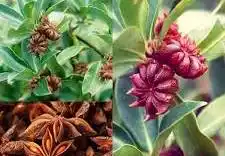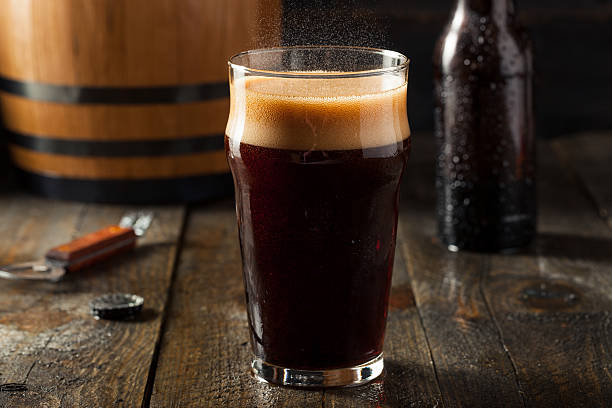Homemade Root Beer or Ginger Beer – Refreshing, Fizzy, and Full of Natural Flavors
Homemade root beer and ginger beer are nostalgic, refreshing beverages that can be made right in your own kitchen. While these drinks have a long history, brewing them at home allows you to create a version that’s free from artificial flavors and preservatives. The rich, complex flavors of root beer come from a blend of roots, herbs, and spices, while ginger beer offers a bright, spicy kick thanks to fresh ginger. Both beverages are naturally fizzy due to fermentation, making them fun and unique homemade sodas.
Root beer and ginger beer are not only great on their own but also make perfect mixers for cocktails, root beer floats, or served as a refreshing beverage on a hot day. With a little bit of time and patience, you can create these flavorful sodas that will delight both kids and adults.
Why Make Root Beer or Ginger Beer at Home?
Making root beer or ginger beer at home gives you control over the flavor, sweetness, and carbonation. You can adjust the spice level in ginger beer to suit your preferences or experiment with different roots and herbs to create a personalized root beer blend. Plus, homemade versions are free from artificial additives, offering a more natural and authentic taste. The fermentation process adds a slight fizz, making them a fun and refreshing treat that’s easy to share with friends and family.
Ingredients and Tools:
The ingredients for homemade root beer and ginger beer can vary depending on the flavor profile you prefer. Both drinks rely on simple fermentation to achieve their natural fizz, so you’ll need sugar, yeast, and water as the base, with various spices and roots for flavoring.
- Ingredients for Root Beer: Sassafras root, sarsaparilla root, wintergreen, star anise, vanilla bean, sugar, yeast, and water.
- Ingredients for Ginger Beer: Fresh ginger, sugar, lemon juice, yeast, and water.
- Tools: A large pot, bottles with airtight lids (for carbonation), a fine mesh strainer, and a funnel.
Here’s a breakdown of the unique ingredients used in homemade root beer: sassafras root, sarsaparilla root, wintergreen, and star anise. These ingredients give root beer its signature, complex flavor and aromatic qualities. Each one brings something special to the mix, and for those unfamiliar with them, here’s what you need to know:
Sassafras Root



- What is it? Sassafras is a tree native to North America, and its root has been traditionally used to make root beer. It has a distinctive, slightly sweet flavor with hints of vanilla and an earthy, woodsy aroma.
- History & Usage: Sassafras was originally used by Native Americans for medicinal purposes and later became a key ingredient in traditional root beer recipes. However, commercial use of sassafras root was restricted in the 1960s due to the presence of safrole, a compound found to be potentially harmful in large quantities. Today, safrole-free sassafras extract is commonly used in making homemade root beer to recreate the traditional flavor.
- Flavor: Earthy, sweet, and aromatic, similar to root beer candy.
Sarsaparilla Root
- What is it? Sarsaparilla is a vine that grows in tropical regions of South and Central America, known for its medicinal properties and aromatic root. The root has been used for centuries to flavor drinks and tonics, including traditional root beer.
- History & Usage: In the 19th century, sarsaparilla was often used in herbal medicine to treat skin conditions, joint pain, and as a general health tonic. Its use in beverages grew over time, and it became a popular ingredient in sodas and herbal drinks, including root beer.
- Flavor: Sarsaparilla root has a deep, slightly bitter, woody flavor with a hint of vanilla and licorice. It contributes to the rich, complex taste of root beer.


Wintergreen
- What is it? Wintergreen is a plant native to North America, and its leaves produce an essential oil commonly used for flavoring. In root beer, wintergreen adds a minty freshness and is often a key flavor note in commercial varieties of the drink.
- History & Usage: Wintergreen oil has been used medicinally for its pain-relieving and anti-inflammatory properties, often found in topical balms and creams. In root beer, wintergreen provides a refreshing, cooling flavor that balances the sweetness and spice of the other ingredients.
- Flavor: Wintergreen has a strong, minty flavor, similar to that of peppermint or spearmint, with a slightly sweet finish. It gives root beer a crisp, fresh edge.


Star Anise
- What is it? Star anise is a star-shaped spice native to China and Vietnam. It is often used in both sweet and savory dishes, especially in Asian and Middle Eastern cuisine. Its essential oils give it a powerful, distinctive flavor.
- History & Usage: Star anise has been used in traditional Chinese medicine for its anti-inflammatory and antiviral properties. In cooking, it’s a key ingredient in five-spice powder and is also used to flavor drinks like mulled wine and tea. In root beer, it enhances the herbal and spice notes of the beverage.
- Flavor: Star anise has a strong, sweet licorice-like flavor, similar to fennel or anise seeds. In root beer, it adds a warm, aromatic sweetness that pairs well with the earthy and woody flavors of sassafras and sarsaparilla.


These ingredients are the building blocks of the rich, aromatic flavor that makes root beer so distinct. Their combination creates a drink that is both familiar and complex, offering layers of sweetness, spice, and herbal notes. While some of these ingredients may seem exotic to those who are new to making root beer from scratch, they are relatively easy to find at specialty stores or online, and they bring the traditional root beer experience to life!
Recipe: Homemade Root Beer
- Yield: About 1 gallon (16 cups)
- Serving Size: 1 cup
- Approximate Nutritional Values per Serving (values are approximate and can vary based on the ingredients used):
- Calories: 110 kcal
- Total Fat: 0 g
- Saturated Fat: 0 g
- Trans Fat: 0 g
- Cholesterol: 0 mg
- Sodium: 5 mg
- Total Carbohydrates: 28 g
- Dietary Fiber: 0 g
- Sugars: 27 g
- Protein: 0 g
Ingredients:
- 2 tablespoons sassafras root (or sassafras root bark)
- 1 tablespoon sarsaparilla root
- 1 teaspoon dried wintergreen leaves
- 2 whole star anise
- 1 vanilla bean, split
- 1 cup granulated sugar
- 1/4 teaspoon active dry yeast
- 1 gallon water
Instructions:
- Prepare the Root Beer Base:
- In a large pot, bring the water to a boil. Add the sassafras root, sarsaparilla root, wintergreen, star anise, and the split vanilla bean. Reduce the heat and let the mixture simmer for about 30 minutes. This will extract the rich, earthy flavors from the roots and spices.
- Strain and Sweeten:
- After simmering, remove the pot from heat and strain the mixture through a fine mesh strainer to remove the solid roots and herbs. Stir in the sugar until fully dissolved. Let the mixture cool to room temperature.
- Fermentation:
- Once the root beer base has cooled, add the yeast and stir to combine. The yeast will ferment the sugar, creating carbonation. Funnel the mixture into clean, airtight bottles, leaving about 2 inches of space at the top.
- Carbonate the Root Beer:
- Seal the bottles tightly and let them sit at room temperature for 12-24 hours to allow the yeast to create carbonation. Be sure to check the bottles after 12 hours; once they feel firm to the touch, they’re ready. Refrigerate the root beer immediately to slow down the fermentation process.
- Serve:
- Serve your homemade root beer chilled over ice or as part of a root beer float with vanilla ice cream. Enjoy the rich, natural flavors of this nostalgic beverage!
Recipe: Homemade Ginger Beer

- Yield: About 1 gallon (16 cups)
- Serving Size: 1 cup
- Approximate Nutritional Values per Serving (values are approximate and can vary based on the ingredients used):
- Calories: 100 kcal
- Total Fat: 0 g
- Saturated Fat: 0 g
- Trans Fat: 0 g
- Cholesterol: 0 mg
- Sodium: 3 mg
- Total Carbohydrates: 25 g
- Dietary Fiber: 0 g
- Sugars: 24 g
- Protein: 0 g
Ingredients:
- 1/2 cup fresh ginger, peeled and grated
- 1 cup granulated sugar
- 1/4 cup fresh lemon juice (about 2 lemons)
- 1/4 teaspoon active dry yeast
- 1 gallon water
Instructions:
- Prepare the Ginger Base:
- In a large pot, bring 4 cups of water to a boil. Add the grated ginger and let it simmer for about 10 minutes to infuse the water with the ginger’s bold, spicy flavor.
- Strain and Sweeten:
- Remove the pot from heat and strain the ginger water through a fine mesh strainer into a large bowl or pitcher. Stir in the sugar and lemon juice until the sugar is fully dissolved. Add the remaining cold water to cool the mixture down.
- Fermentation:
- Once the ginger base has cooled to room temperature, add the yeast and stir to combine. Funnel the mixture into clean, airtight bottles, leaving about 2 inches of space at the top.
- Carbonate the Ginger Beer:
- Seal the bottles and leave them at room temperature for 12-24 hours to allow the yeast to ferment and create carbonation. Once the bottles feel firm, refrigerate them to stop the fermentation process.
- Serve:
- Serve the ginger beer chilled over ice. You can also mix it into cocktails like Moscow Mules or Dark ‘n’ Stormys for a refreshing twist!
Tips for Perfect Homemade Root Beer or Ginger Beer:
- Don’t Overferment: Keep an eye on the bottles during fermentation. If left too long at room temperature, the pressure can build up and cause the bottles to burst. Always check for firmness and refrigerate immediately when they’re ready.
- Adjust the Sweetness: If you prefer your drinks less sweet, you can reduce the amount of sugar. Keep in mind that the sugar is necessary for fermentation, so you’ll need enough for the yeast to work.
- Try Different Flavors: For root beer, you can experiment by adding spices like cinnamon, clove, or licorice root. For ginger beer, you can add fresh mint or lime juice for a zesty twist.
Creative Variations for Root Beer and Ginger Beer:
- Vanilla Root Beer: Add extra vanilla bean or vanilla extract to enhance the creamy notes in your homemade root beer.
- Spiced Ginger Beer: Add a pinch of cinnamon, cloves, or cardamom to your ginger beer for a warm, spiced flavor.
- Fruit-Infused Ginger Beer: Muddle fresh fruits like raspberries, blackberries, or strawberries and add them to the ginger beer before serving for a fruity twist.
Storing Homemade Root Beer or Ginger Beer:
Once carbonated, store your homemade root beer or ginger beer in the refrigerator. It will last for about 1-2 weeks, but be sure to open the bottles carefully, as the carbonation will continue to build up slowly over time.
Health Benefits of Ginger Beer:
Ginger is well-known for its anti-inflammatory and digestive benefits. Drinking ginger beer can help soothe an upset stomach or aid digestion after meals. However, homemade ginger beer should be enjoyed in moderation due to its sugar content.
Fun Fact:
Did you know that root beer has been brewed since the 1600s? Originally made by Native Americans from the roots of the sassafras tree, it was later popularized as a soft drink in the United States. Ginger beer also has a long history, dating back to the 18th century in England, where it was brewed as a fermented, alcoholic drink.

